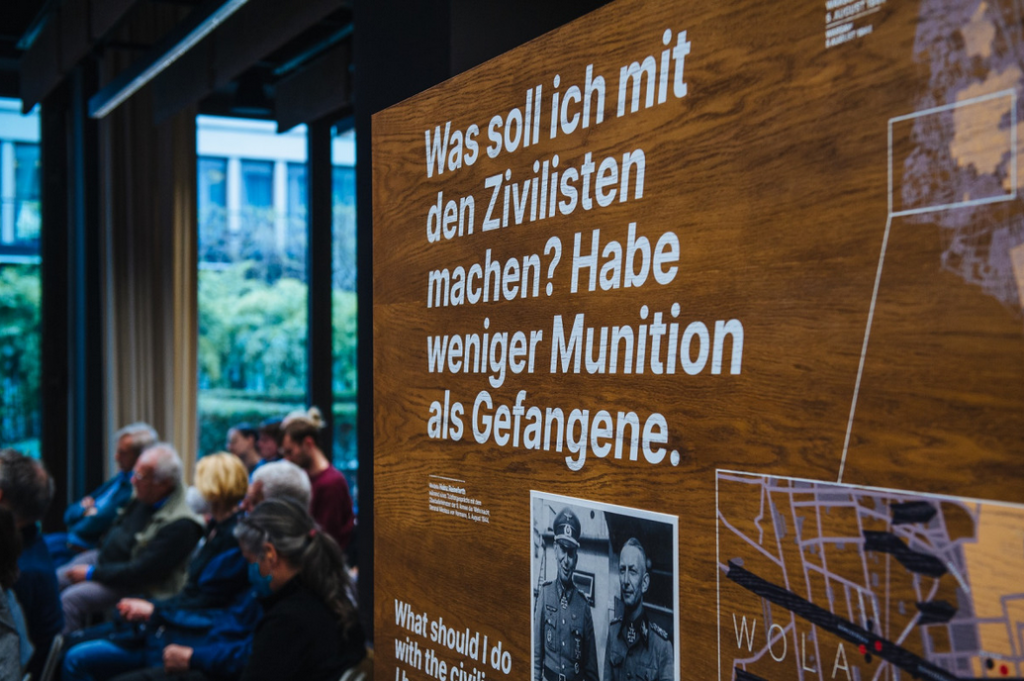
On April 24, at the Pilecki Institute in Berlin, a new exhibition about the Wola Massacre was officially opened. “Das Massaker von Wola in Warschau, August 5, 1944. Ein unbestraftes Kriegsverbrechen”. The exhibition in German explains, among other things, why the perpetrators of this monstrous crime against the Polish population have never been punished.
The exhibition has been shown in various versions before, among others, at the Warsaw Uprising Museum and the Landesarchiv Schleswig-Holstein, where it met with considerable media interest. To the current version of the exhibition, recordings of witnesses and a separate board with the game ‘Shadow Hunters’, maintained in the Point&Click convention, in which the player plays the role of a young lawyer who demands justice in post-war Germany and tries to collect evidence of Heinz Reinefarth’s guilt, meeting on his way, among others, Fritz Bauer, have been added.
The exhibition “also contains the documentation of the investigation: it shows why Reinefarth could not be punished and that it was not due to a lack of evidence or too complicated legal procedures or other objective difficulties” – said Patryk Szostak, spokesman for the Pilecki Institute in Berlin in an interview with PAP. “This was due to the lack of political will and atmosphere in society and in the German judiciary at that time” – Szostak added.
Hanna Radziejowska, director of the Pilecki Institute in Berlin, emphasized in an interview with “Deutsche Welle” that Reinefarth was not prosecuted for crimes of genocide or crimes against humanity: “He was prosecuted for murder all the time. And to prove murder, you need to find a gun, prove that he shot, and you need a witness. It wasn’t that kind of crime” – she explained. “Today, from the perspective of the Russian invasion of Ukraine, it should be a warning about how difficult it is to convict for such obvious crimes” – Radziejowska emphasized. “It seemed to the Poles that these crimes were so cruel that all perpetrators should be convicted. What a shock it was that for most of them were not convicted” – she added.
“There will also be a short fragment showing how Reinefarth himself spoke about it, explaining that he did not know anything, that he condemned the executions and that everyone fought in the Uprising, including women and children, so sometimes soldiers shot at them” – says Patryk Szostak, spokesman for the Pilecki Institute in Berlin in an interview for PAP.
The spokesman stressed that “this is obviously not the only example of its kind, rather it is a very telling tip of the iceberg”. Reinefarth “after his political career returned to the profession of lawyer without any additional questions, for example, the code of ethics of the profession of lawyer played no role here. He died respected as a decent citizen, as a recognized representative of the German elite”. Patryk Szostak noted that “it says a lot about those times, it is also an important chapter in Polish-German relations. From this angle, we carry out the mission of our Institute – we are in favor of Polish-German reconciliation, but always based on historical research, even if they are uncomfortable”.
“It should be emphasized that the exhibition is largely the result of many years of research by the director of the Berlin branch of the Pilecki Institute, Hanna Radziejowska, and was also created thanks to the initiative of the director of the Pilecki Institute in Warsaw, Prof. Magdalena Gawin” – Szostak told PAP.
“Many new documents have appeared, including a collection of over thirty original photographs taken by Hanns von Krannhals, a German historian of the Warsaw Uprising, who in 1962 made a local vision in places of mass executions in Wola and took these photos there” – the spokesman emphasized. “There are also handwritten sketches depicting the course of events in August 1944, the location of machine guns, etc.”
“We hope that this exhibition will reach as large a part of the public opinion in Germany as possible” – said Szostak. “It will also be very helpful that we have a really extensive and – I must emphasize it – excellent education department, where workshops are held every week, which have more and more interesting innovative forms. For example, we have created a historical card game about the Second World War, where are the most important dates and facts concerning the German occupation of Poland, i.e. that area of history which, in our opinion, is still insufficiently discussed and present in the common consciousness in Germany. The exhibition will be accompanied by a whole program of accompanying events with lectures by Radziejowska, or Piotr Gursztyn, the author of a monograph on this subject, but also German historians” – Szostak told PAP.
The Pilecki Institute in Berlin prepared the exhibition in cooperation with the Landesarchiv Schleswig-Holstein, the Polish Ministry of Culture and National Heritage, the Wola Cultural Center and the Wawelberg Colony.
The slaughter of the inhabitants of the capital city of Wola lasted from 5 to 7 August 1944. According to various estimates, 40,000 to 60,000 people died in mass executions, inhabitants of the district. The people were shot and the bodies of the dead were burned. The large-scale extermination ended on August 7, but to a lesser extent, it lasted until August 12, when General Erich von dem Bach-Zelewski, who commanded the operation to suppress the Warsaw Uprising, issued a ban on murdering civilians. After the war, none of the perpetrators of this crime was held accountable.
AW
Source: Pilecki Institute
